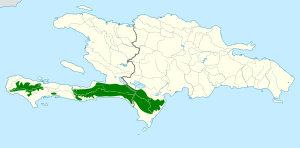Western chat-tanager facts for kids
Quick facts for kids Western chat-tanager |
|
|---|---|
| Conservation status | |
| Scientific classification | |
| Genus: |
Calyptophilus
|
| Species: |
tertius
|
 |
|
| Synonyms | |
|
Calyptophilus frugivorus tertius |
|
The western chat-tanager (scientific name: Calyptophilus tertius) is a special type of bird. It belongs to a bird family called Calyptophilidae. This bird is considered a vulnerable species, which means it needs protection. It lives only on the island of Hispaniola. This island is shared by two countries: the Dominican Republic and Haiti.
Contents
About the Western Chat-Tanager
How it's Classified
The western chat-tanager is closely related to the eastern chat-tanager. For a long time, scientists thought they were the same species. But now we know they are different. They likely became separate species on two old islands. These islands later joined to form Hispaniola.
This bird's family, Calyptophilidae, is quite unique. It used to be grouped with "true" tanagers. But in 2017, scientists decided it needed its own family. The western chat-tanager is the only type within its specific group.
What it Looks Like
The western chat-tanager is about 20 to 21 centimeters (8 to 8.3 inches) long. It weighs between 40 and 55 grams (1.4 to 1.9 ounces). It has a long beak and a long tail. This makes it look a bit like a mockingbird.
Both male and female birds look the same. Their heads are dark olive-brown. The top of their head is almost black. They have a small rusty spot near their eye and beak. The rest of their upper body is dark reddish-brown. Their throat and belly are white. The sides and lower belly have a grayish-brown color.
Where it Lives
The western chat-tanager lives in the highest mountains of Hispaniola. You can find it in southwestern Haiti. This includes areas like the Massif de la Hotte. It also lives in the Chaîne de la Selle. In the Dominican Republic, it lives in the Sierra de Bahoruco.
This bird prefers broadleaf forests. It also likes dense, bushy areas. It is often found in ravines and near water. It lives at elevations between 745 and 2200 meters (2,444 to 7,218 feet).
Behavior and Life
Movement and Habits
The western chat-tanager stays in its home area all year. It does not migrate. This bird is quite secretive. You will usually find it on or very close to the ground.
What it Eats
Scientists do not know much about what the western chat-tanager eats. Its diet is probably similar to the eastern chat-tanager. The eastern chat-tanager looks for food on or near the ground. It often forages in pairs. It mainly eats insects and other small creatures. It also eats a small amount of fruit.
Reproduction and Nests
The breeding season for the western chat-tanager is thought to be from May to July. Only two nests have ever been found and described. These nests were large and shaped like a dome. They were made from rough materials. This included woody stems, vines, moss, and lichen. The inside was lined with softer materials.
The nests were placed about 1 to 1.5 meters (3.3 to 4.9 feet) above the ground. One nest had two eggs. After the eggs hatched, both parents fed the baby birds.
How it Sings
Both male and female western chat-tanagers sing. They usually sing early in the morning. Their song sounds buzzy. It is described as "wee-chee-chee-chee." They also make calls. These calls include a "chip-chip" sound. Another call is a quick "tick, tick, tick, tick..."
Conservation Status
The IUCN (International Union for Conservation of Nature) has listed the western chat-tanager as a Vulnerable bird. This means it is at risk of becoming endangered. It lives in a small area. Its population is estimated to be between 6,700 and 13,300 adult birds. This number is believed to be getting smaller.
The biggest threats to this bird are logging. This is when trees are cut down. Another threat is when its habitat is turned into farmland. Nest predation is also a problem. This means other animals eat the eggs or baby birds. The main predators are black rats, brown rats, and feral cats.
The western chat-tanager is "fairly numerous" in some local areas. It lives in some protected areas. However, in Haiti, these protected areas do not always get enough support.
See also
 In Spanish: Calyptophilus tertius para niños
In Spanish: Calyptophilus tertius para niños


